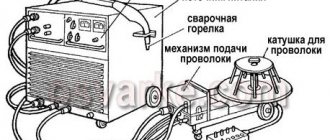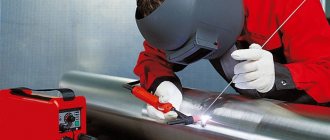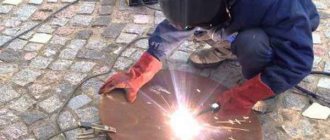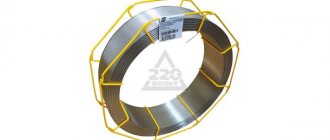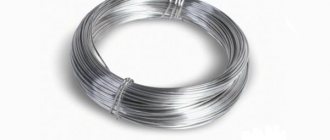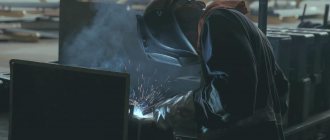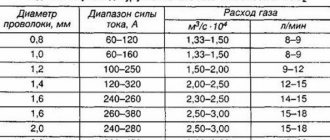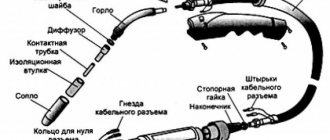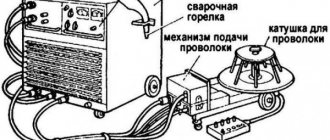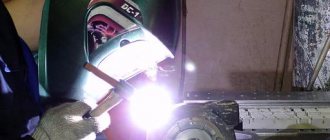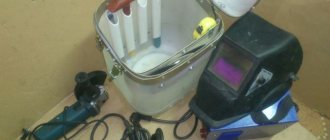Home page » flux cored welding wires
This section discusses flux-cored welding wires.
For blacksmiths, forges, industries and individuals (homemade workers, self-taught people and enthusiasts).
See below for useful information to help you choose.
Choose brands from the list below the article.
Flux-cored welding wire (0.8 mm; 1 kg) Elitech. Photo VseInstruments.ru
Progress in the development of welding technologies is expressed in the emergence of new types of consumables. Flux-cored welding wire is successfully competing in this market.
Scope, purpose
Flux-cored (flux-cored) welding wire is used to join carbon steels, steels with different levels of alloying (more about alloyed wires here) and cast irons. In addition, it is used to obtain special properties of surfaces using surfacing.
The main advantage is the ability to obtain a high-quality weld without the use of a protective gas environment . The absence of a cylinder and communications to it creates conditions for ensuring mobility during work .
Reference. Tig welding wire is not so popular, but is in demand for various tasks.
Welding can be done in the most inaccessible places ; flux-cored wire welding technology is resistant to various unusual circumstances in open areas.
Video
Symbols and markings
The name of flux-cored wires is carried out in accordance with GOST 26271-84. For example, let's look at the following: PP-AN3-2.5-PS-49-V2VP GOST 26271-84.
- PP-AN3 – brand (cored wire, development associated with the Academy of Sciences, series number 3).
- 2.5 – diameter 2.5 mm.
- PS – self-protecting wire (can be designated PG – gas-protecting wire).
- 49 – value of the yield strength of the suture material (no more than 490 MPa).
- B – corresponds to the chemical composition of the content of carbon, phosphorus and sulfur in the deposited metal (A, C are allowed).
- 2 – impact strength value (can have symbols P, K, from 0 to 6).
- VP - determines the permissible spatial positions when carrying out welding work, in this case vertical with the forced formation of a welding seam. The following symbolism may occur:
- N – lower;
- G – lower and horizontal;
- B – lower, horizontal and vertical;
- GP – horizontal with forced formation of a seam;
- UP – all positions with forced formation of a seam.
Flux-cored welding wire STURM! WW1001F. Photo 220Volt
The name of welding flux-cored wire for surfacing is regulated by GOST 26101-84. Let's look at an example: PP-Np-18Х1Г1М-С- 2,2-1 GOST 26101-84.
- PP-Np-18Kh1G1M – flux-cored wire for surfacing, material 18Kh1G1M.
- C - surfacing is carried out without gas or other protection, self-protecting (may be labeled F - submerged arc surfacing, G - gas surfacing, U - universal wire, used in all cases).
- 2.2 – diameter 2.2 mm.
- 1 – accuracy class of maximum diameter deviations, there is also a 2nd accuracy class.
Reference. More information about the marking and classification of wire is presented here.
Steel
Wire is distinguished by purpose: for welding or surfacing.
In total, about 80 grades of wire are produced.
The letters “Св” mean that the wire is welding. A hyphen indicates the grade of steel from which the wire is made. The first digit corresponds to the carbon content in hundredths of a percent. The letters indicate the presence of alloying elements in percentages, which are indicated by the number following the letter designation.
For welding low-carbon steels, six grades are used: Sv-08, Sv-08A, Sv-08AA, Sv-08GA, Sv-10GA, Sv-10G2,
For low and medium alloy steels - 30 grades, for example: Sv-08GS, Sv-08G2S, Sv-18KhGS, etc.
For welding high-alloy steels, 41 grades of wire are used: Sv-08Kh14GNT, Sv-12Kh13, etc.
If there is no number after the letter, then the amount of this element does not exceed 1%. The letter “A” at the end of the marking indicates a reduced content of sulfur and phosphorus, and the letter “AA” indicates an even lower amount.
Low-carbon and alloyed wires are produced non-copper-plated and copper-plated (symbol - O). Copper plating protects the wire from oxidation and improves current supply.
The letter “E” may appear at the end of the marking. “E” means that the wire is used to make electrodes. The letters “Ш”, “ВД” or “VI” indicate that the steel for the wire was made, respectively, by electroslag, vacuum-arc remelting or in vacuum induction furnaces.
An example of a symbol for welding wire with a diameter of 3 mm, grade Sv-08A, with a copper-plated surface made of steel obtained by electroslag remelting:
| Welding conditions | Recommended wire |
| Low-carbon and low-alloy steels in carbon dioxide and mixtures of active gases | Sv-08G2S |
| Low carbon and low alloy steels in argon and helium | Sv-08GS |
| Welding in carbon dioxide outdoors | Sv-20GSUT |
| Construction metal structures made of steel 16G2AF in carbon dioxide | Sv-10ХГСН2МУ |
| Metal structures made of steel 10HSND in carbon dioxide | Sv-08G2SDYU |
| High-strength low-alloy steels (type 14ХГНМ) in carbon dioxide | Sv-10ХН2Г2СМА |
| Steels 08Х22Н6Т and 08Х18Г8Н2Т in carbon dioxide | Sv-08Х20Н9С2БТУ |
Wire for welding medium-carbon and heat-resistant steels
| steel grade | Welding wire grade | |
| in nitrogen, helium | in carbon dioxide | |
| 20ХГСА | Sv-15XMA, Sv-18KhGSA | Sv-08G2S |
| 30ХГСА | Sv-15XMA, Sv-18KhGSA | Sv-10GSM, Sv-10GSMT, CB-08X2CMA, Sv-15XMA, Sv-18KhGSA, Sv-08KhZG2SM |
| 12XM | Sv-08XM | Sv-10ХГ2СМА |
| 15ХМ | Sv-08ХМ | Sv-08HNSMA, Sv-08HG2SM, Sv-08HGSMA |
| 12Х1МФ | Sv-08HMFA | Sv-08KhGSMFA |
| 15Х1МФ | Sv-08ХМ | Sv-08X1M1GSF |
| 15X5M, 15X5, 15Х5ВФ | Sv-10X5M, Sv-08G2S | Sv-08G2S |
Steel welding wire is available in the following diameters (mm): 0.3; 0.5; 0.8; 1.0; 1.2; 1.4; 1.6; 2.0; 2.5; 3.0; 4.0; 5.0; 6.0; 8.0; 10.0 and 12.0, Wire is supplied in coils with a diameter of 150-750 mm, weighing from 1.5 to 40 kg, and also wound on reels and cassettes.
The surface of the wire must be clean and smooth, without cracks, delaminations, caps, sunsets, shells, nicks, scale, rust, oil and other contaminants.
If necessary, the wire is cleaned by sandblasting or etching in a 5% solution of hydrochloric acid. You can clean the wire by passing it through special mechanical devices, as well as with sanding paper until it has a metallic shine. Before cleaning, it is recommended to anneal the wire coil at a temperature of 150-200°C for 1.5-2 hours.
A certificate indicating the manufacturer, wire symbol, heat and batch number, surface condition and its chemical composition is required. If the certificate is lost, the wire can be used only after its chemical composition has been determined.
Wire for arc welding in inert gases
| steel grade | Wire grade |
| Chromistykh | |
| 08X13 | Sv-12Х13, Sv-08Х14GNT |
| 08X17T | Sv-07Х25Н13, Sv-06Х25Н12ТУ, Sv-08Х25Н12ТУ, Sv-10Х17Т |
| 15X25T | Sv-06Х25Н12ТУ, Sv-08Х25Н13БТУ, Sv-10Х17Т |
| 0X13 1X13 | Sv-10Х13, Sv-06Х14 |
| 2X13 | Sv-08X14GT |
| High alloy | |
| 12X18H10T, 12X18H12T, 08Х19Н10Т | Sv-06Х19Н9Т |
| 03X18H11 | Sv-01Х19Н9 |
| 08Х22Н6Т | Sv-07Х25Н13 |
| 08Х18Н12Б | Sv-07Х19Н10Б |
| 10Х17Н13М2Т, 08Х17Н15М3Т, 08Х21Н6М2Т | Sv-06Х19Н10М3Т |
| 08Х20Н14С2 | Sv-04Х19Н9С2 |
| 10Х23Н18 | Sv-10Х20Н15, Sv-07Х25Н13 |
| 06Х23Н28МДТ | Sv-01Х23Н28М3Д3Т |
| 03X16H15M3 | Sv-04Х19Н11МЗ |
| 08Х18Г8Н2Т | Sv-08Х20Н9С2БТУ |
Kinds
Flux-cored wire is produced in two types: gas-protective and self-protective.
Gas-protective wire DEKA E71T-1С 1.2 mm. per package 15 kg. Photo by DEKA
Gas-protective is mainly used when working with semi-automatic devices or automatic machines in an environment of inert gases. In order to improve the quality of welding, the surface is coated with copper.
Flux cored (self-shielding) welding wire DEKA E71TGS. Photo by DEKA
Self-shielding wire contains the necessary components for obtaining a high-quality seam in the composition of the powder. Therefore, for welding you will only need a lightweight semi-automatic hose machine, where a reel of wire is placed. How wire is threaded, material consumption rates, feeding mechanism and other information are collected in a separate article.
Popular brands
This video will show the difference in the work of these two types.
Types of aluminum wire and rules for its use
Aluminum welding wire for semi-automatic machines consists of individual rods or coils of a certain diameter. In any case, they are hermetically sealed. The first feature of using this material is connected with this.
- Electrodes for working on aluminum are not recommended for use when carrying out important work that requires high quality. They are suitable not for industrial purposes, but for home and household purposes.
The fact is that aluminum under normal conditions is covered with a durable and elastic oxide film. Its melting point is about 2500º C. At the same time, the melting of pure aluminum is not higher than 600º C. For alloys the situation is not much different.
- To effectively clean and degrease aluminum and its alloys, it is recommended to supplement mechanical cleaning with the use of chemicals (for example, white spirit, acetone or a special hot alkaline bath)
A consequence of this feature of aluminum and its alloys is the need to first remove the oxide film from the surface of the parts being joined (for example, with a mechanical or hand tool). The electrode itself must be initially free of oxide.
- If the package of electrodes is not completely used up, it must be sealed again with silica gel added inside to absorb moisture.
Aluminum wire for semi-automatic machines
When choosing a wire for welding aluminum alloys, you need to consider what qualities are required from the future weld:
- Seam tensile strength.
- Plasticity of the connection.
- Corrosion resistance.
- Resistant to cracking from heat.
- The diameter of the aluminum wire for semi-automatic welding without gas should be 0.3-0.5 mm greater than the thickness of the parts it welds
It is most convenient to use the table below.
When using welding electrodes, you need to remember the need for their preliminary preparation. In a special purchased or home-made oven, preliminary uniform heating of the electrodes and their so-called roasting are carried out. This will allow you to form a very high-quality seam.
- Aluminum does not change its color when heated, unlike many other metals, so you need to be especially careful when working with it - it’s easy to burn through
In addition to preliminary preparation of the electrodes, you always need to prepare the parts to be connected. They need to be heated evenly in advance. And ensure that this uniform heating is maintained throughout the formation of the seam.
- An alkaline bath is the most effective way to comprehensively remove oxide films and degrease aluminum parts. To do this, you need to make a special solution of 2 liters of pure water, 100 g of trisodium phosphate, 100 g of soda and 50 g of liquid glass. The solution must be heated to a temperature of 60-70º C
It is also necessary to take into account that aluminum tends to cool unevenly and, as a result, crack. Of course, this is compensated by the plasticity of this metal. But if the welds are placed too close to each other (about 10-15 mm ), then cracks will certainly appear.
- Molten aluminum and its alloys are very fluid. That is why all seams are made in one layer in one pass. Where possible, it is recommended to use molten metal containment liners
Popular brands
flux-cored wire is offered on the Russian market . Having a diameter of 0.8 mm, it is welded both in protective gas and without it. Performs welding of low-carbon and low-alloy steels in any position.
Flux cored (flux-cored) welding wire WESTER FW08100. Photo 220Volt
The American brand Lincoln Electric offers self-protective NR-208-XP . Welding is performed without external protection. Recommendations for use: hard-to-reach places, in particular at high altitudes and in open areas (unstable wind conditions, high humidity). For operation, a semi-automatic device is used in the “NO GAZ” operating mode. You just need to set the desired polarity. Since the wire has a hollow structure, the broaching rollers must be tightened very carefully.
Quattro Elementi 770-377 – flux-cored welding wire. The filler contains all additives that allow welding without gas. Manufacturer from Italy.
Welding flux-cored wire QUATTRO ELEMENTI 770-377. Photo VseInstruments.ru
G70 – gas-protected welding wire from . The composition of the powder allows you to adjust the properties of the weld. are made from high-strength steel. A protective environment of a mixture of gases allows for multi-pass welding without stripping the seam , thereby ensuring high welding productivity. A high-quality seam is formed in any position.
Reference. There are popular brands of other types of wire on the market of welding materials: titanium wire VT1-00Sv, wire for cast iron PANCH-11, copper-plated ER70S-6.
Features of the use of cored wire
Welding with it is often used when installing large metal structures in unusual conditions (for example, at a height or, on the contrary, underground). Despite the fairly high quality of the seam, it is not suitable for welding highly loaded joints and pipes designed for significant operating pressure.
Flux-cored wire for semi-automatic machines has a wide range of grades - they differ in sheath material and powder composition. This must be taken into account when welding different metals or their alloys. Each of them requires its own variety.
Another feature of working with it is to set straight polarity on the semi-automatic welding machine before starting work. Since this is usually done by switching the terminals inside the device body, it is also worth calibrating the pressure rollers that ensure the supply of consumables from the reel.
The rollers should press on it with just enough force to ensure its movement and fixation. Any deformation by pressure rollers is unacceptable - this will lead to damage and jamming of the wire in the cable channel of the semi-automatic welding machine.
And finally, you should take care of the burner tip. Before the flux-cored wire for a semi-automatic machine appears when fed from the torch, the tip must be unscrewed. And only after it comes out, screw it back on, but without the nozzle. Since gas is not supplied, there is no need for a nozzle.
The main thing is to choose the optimal ratio of the diameter in the tip and the thickness of the supplied electrode - they should be as close as possible, but not coincide. It is recommended to coat the tip itself ahead of time with a special substance that protects against the adhesion of drops of melt and slag.
Characteristics
Characteristic features include the design features of the wire. The original versions were made by rolling a thin sheet into a tube, leaving a clear parting line on it. This affected the properties of the filler due to the possibility of interaction with the external environment.
Subsequently, a technology was developed for producing solid tubes and ensuring their dense filling with powder. This improved not only the safety of the powder, but also the mechanical characteristics of the welding wire. This indicator is important when pulling through feed rollers on semi-automatic machines.
Self-protective flux cored wire E71T-11 (1.2 mm; 1 kg) Bars. Photo VseInstruments.ru
The compositions of the powders determine the possibility of using the wire in a particular welding technology:
- rutile and rutile-fluorite use gas protection;
- rutile-organic are self-protective;
- carbonate-fluorite work with gas protection, improve the plasticity of the weld;
- fluorite have the properties listed and can operate without gas protection.
The advantages of welding flux-cored wire are manifested when performing surfacing technological operations. The high deposition rate makes it possible to perform deposition in a wide range of required parameters. Chemical components, such as nickel, chromium and others, can be added to the powder to obtain the required properties of the deposited surface.
As you can see, for each individual welding technology, certain characteristics of the welding wire should be selected.
Types of cored wire
Flux-cored wire for semi-automatic machines is divided into four types according to the nature of its design:
- simple tubular shape;
- with one bend of the shell;
- with two shell bends;
- two-layer.
Its overall dimensions vary in a wide range of diameters - from 0.8 mm to 2.5 mm.
A simple tubular one can have slight nuances in its design - it can either be seamlessly drawn from one piece of metal, or bent from a sheet of metal into a cylinder with a butt joint. There may also be an overlap connection between the workpiece and the shell.
A special powder is evenly placed inside the wire. Its composition may vary depending on the purpose of the parts being welded and the characteristics of their further operation.
In general, the powder consists of ferroalloys, minerals and other chemicals of complex composition. In any proportion, they create a protective layer of neutral gas that separates the melt from atmospheric oxygen. In addition, the gas released by the powder:
- alloys;
- deoxidizes;
- stabilizes the electric arc;
- simplifies the formation of a uniform seam.
Depending on the composition of the powder, self-shielding wire for semi-automatic machines is divided into types:
- Fluorite;
- Fluorite-carbonate;
- Rutile;
- Rutile-fluorite;
- Rutile-organic.
All of the above types have self-protective properties. To weld with them, there is no need for an additional carbon dioxide cylinder.
Requirements
to flux-cored wire :
- easy excitability of the arc and stability of its functioning;
- the wire should be systematically consumed during melting with a minimum spatter factor;
- the slag should cover the entire seam so that after welding it can freely separate after cooling;
- the powder must fill the internal cavity without voids so that the weld is obtained without porous areas and other similar defects.
Flux cored welding wire Cedar. Photo 220Volt
Manufacturers
The pioneer in the use of flux-cored wire for welding technologies is the American one. Therefore, today it is the undoubted leader in the production of these products. Self-shielding wire NR-208-XP and gas-shielding wire G70 mentioned in the article are the brainchild of this manufacturer.
Welding cored wire ESAB Coreshield 8. Photo Welding Technologies
A large range is produced by the Swedish manufacturer ESAB . There is wire for hardening surfacing (Stoody 100HC-O), powder wire for low-carbon steels (Coreshield 8), for low-alloy steels (OK Tubrod 14.01), gas-protective wire for stainless steels (OK Tubrod 15.30) and powder wire for cast iron (Nicore 55).
The high quality of the products contributes to the popularity of other types of wire: copper, polished, copper-bonded (coated steel).
DEKA offers a wide selection of cored wires. The company's product range includes self-protective and gas-protective consumables. The manufacturer from China offers products at affordable prices, which makes other types of wire in demand: stainless steel, aluminum.
ESAB welding wire
Consumable material in the form of welding wire is widely used in various welding technologies. The presence of this product in the range of manufacturers with influence in the welding materials market is a prerequisite. ESAB, as a world leader, is distinguished by its production of wide-purpose wires, covering all possible areas of its application. Areas of application ESAB welding wire is in demand in oil and gas, shipbuilding, mechanical engineering, chemical and other industries. IN…
What are cored wires made of?
Before we dwell in more detail on the characteristics and areas of application of wires, let’s talk about their composition.
Regardless of the type, such wire includes a core covered with a sheath. The core is also called filler.
A strip made of steel (usually low-carbon cold-rolled) is used as a shell in the wire. Please note that the tape is used without preliminary polishing. It is particularly soft.
The filler in the wire is flux and powder (metal), or other fillers.
Welding wire: consumption, threading, feeding
To perform one-time welding work at home, you need to decide on the amount of consumables that you will need to purchase in the store. In industrial conditions, the amount of welding wire consumed will affect the final price of the product produced and, ultimately, customer demand. Features of wire Wire consumption is influenced by many factors, including the human factor in the context of whether the welder has the required qualifications. However, the most objective is the meaning...
Welding wire manufacturers
Wire is a consumable material that is in high demand today. Therefore, many companies, in Russia and abroad, specialize in the production of welding wire. The most significant manufacturers, as well as the features of their products, popular brands of consumables and other information useful for craftsmen are presented in this review. List of countries and manufacturing plants The company has modern equipment at its disposal, qualified employees of the enterprises use the latest…
Welding wire: brands, markings, types
Welding work is carried out with any materials - it can be cast iron, steel or non-ferrous metals. Technologies make it possible to perform these works on productive automatic and semi-automatic machines. The functionality of this equipment is ensured by consumables in the form of wire. Application The main purpose is to use consumables on semi-automatic machines in an atmosphere of protective gas. In cases where self-shielding wire is used, welding is performed without gas. The wire is used as surfacing…
Marking of solid welding wire.
Different welding wires are used for different conditions and materials. Any welding wire is marked so that the welder can easily select the wire he needs at the moment. Below is a table of wire markings.
The wire grade contains the following information:
1. Purpose of the wire:
SV-welding wire
NP – surfacing wire
2. Carbon content in the wire composition. It is indicated in hundredths of a percent (0.01%)
3. The type and percentage of ligating elements may be specified. The element used has the following letter designations:
G – manganese, D – copper, M – molybdenum, N – nickel, T – titanium, F – vanadium, X – chromium, C – zirconium, Yu – aluminum.
After the letter of the alloying element there is a designation of its content in percentage.
Additionally, the percentage of sulfur and phosphorus impurities can be indicated. Marked with the letters A and AA.
Nowadays, copper-plated welding steel wires are more often used. Thanks to the use of a protective copper layer, the wire is not subject to corrosion.
The trend in modern production has become the use of gas exhaust structures (for example, Miller FILTAIR) or the transition to an anti-corrosion coating without copper plating.
Flux-cored welding wire is a tubular wire filled with powder filler . Depending on the manufacturer, purpose and price category, flux-cored welding wires have different compositions , cross-section types and powder/metal sheath mass ratios.
The design of flux-cored wire can be simple, tubular, curved or multi-layered. More details about the most common types of wire sections can be found in the image. The ratio of powder mass to metal mass in the wire ranges from 12% to 45% .
Bends and several layers of laying give the wire additional strength and prevent powder from spilling out when fed by a semi-automatic welding machine. Depending on the type, the powder filler is capable of performing the functions of air protection , weld formation and alloying , arc stabilization and transfer of welding droplets .
Depending on the needs of production, self-shielding wires or wires for welding in shielding gases are used. Self shielding welding wire
The main advantage of flux-cored wires is their ease of use in “non-standard” conditions. Welding with flux-cored wire allows you to weld with greater speed and ease in any plane, at any angle and with different depths of weld penetration.
Welding wire deck
The DEKA trademark is represented on the market with products related to welding technology. In addition to welding equipment and welder protective equipment, a large range of consumables is sold - welding wire, which has found application in many areas of business where there is a need to create strong connections: in the manufacture of various types of industrial, medical and some other types of equipment of complex design. Also in the shipbuilding industry and mechanical engineering. What…
